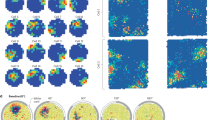Abstract
RENSHAW1 showed that stimulation of ventral roots of the cat spinal cord may inhibit motoneurones. This also occurs when muscle nerves are stimulated in preparations with cut dorsal roots. Renshaw proposed several alternative hypotheses to account for this. One was that aiiti-dromic action potentials in motor axons propagate along collaterals which terminate within the ventral horn2 and inhibit motoneurones either directly or through an inter-neurone. The discovery by Renshaw of ventral horn interneurones which were discharged repetitively by ventral root stimulation gave support to this idea. Eccles, Fatt and Koketsu3 reported evidence for synaptic links between cholinergic terminals of ventral root axons and the interneurones of Renshaw and between the inter-neurones and motoneurones. They also provided evidence against a second hypothesis of Renshaw that recurrent inhibition may be produced by interaction between the dendrites of motoneurones. There is as yet little direct evidence against the third hypothesis of Renshaw that afferent fibres within the ventral roots might inhibit motoneurones. Such afferents would have to arise, at least in part, from muscle to account for recurrent inhibition produced by muscle nerve stimulation. There is evidence for the presence of aiferents in ventral roots. Sherrington4 found as many as forty degenerating axons in chronically sectioned ventral roots. He confirmed previous observations that there are often a few ganglion cells within the ventral root, although he failed to demonstrate a relationship between the “recurrent” afferent fibres and the ganglion cells. Ventral root afferents have recently been described in the cat5 and the rat6; at least some of them appear to arise from muscle6.
This is a preview of subscription content, access via your institution
Access options
Subscribe to this journal
Receive 51 print issues and online access
$199.00 per year
only $3.90 per issue
Buy this article
- Purchase on Springer Link
- Instant access to full article PDF
Prices may be subject to local taxes which are calculated during checkout
Similar content being viewed by others
References
Renshaw, B., J. Neurophysiol., 4, 167 (1941); J. Neurophysiol., 9, 191 (1946).
Scheibel, M. E., and Scheibel, A. B., Arch. Ital. Biol., 104, 328 (1966).
Eccles, J. C., Fatt, P., and Koketsu, K., J. Physiol., 126, 524 (1954).
Sherrington, C. S., J. Physiol., 17, 211 (1894).
Mikeldaze, A. L., Arkh. Anat. Gistol. Embriol., 40, 3 (1965).
Dimsdale, J. A., and Kemp, J. M., J. Physiol., 187, 25P (1966).
Willis, W. D., and Willis, J. C., Arch. Ital. Biol., 104, 354 (1966).
Thomas, R. C., and Wilson, V. J., Nature, 206, 211 (1965).
Lapham, L. W., Johnstone, M. A., and Brundjar, K. H., J. Neuropath. Exper. Neurol., 23, 156 (1964).
Brock, L. G., Coombs, J. S., and Eccles, J. C., J. Physiol., 122, 429 (1953).
Rexed, B., J. Comp. Neurol., 96, 415 (1952).
Eccles, J. C., Libet, B., and Young, R. R., J. Physiol., 143, 11 (1958).
Author information
Authors and Affiliations
Rights and permissions
About this article
Cite this article
WILLIS, W., GRACE, R. & SKINNER, R. Ventral Root Afferent Fibres and the Recurrent Inhibitory Pathway. Nature 216, 1010–1011 (1967). https://doi.org/10.1038/2161010a0
Received:
Revised:
Published:
Issue Date:
DOI: https://doi.org/10.1038/2161010a0
This article is cited by
-
Motoneuronal interaction in spinal cord isolated from infant rats
Neurophysiology (1988)
-
Distribution of myelinated and nonmyelinated nerve fibers of a cat cutaneous nerve in the spinal roots
Neurophysiology (1976)
-
Properties of axons of sympathetic preganglionic neurons in the cat lumbar spinal cord
Neurophysiology (1975)
Comments
By submitting a comment you agree to abide by our Terms and Community Guidelines. If you find something abusive or that does not comply with our terms or guidelines please flag it as inappropriate.



